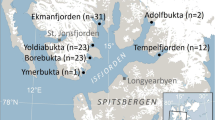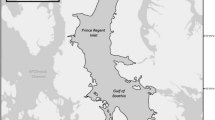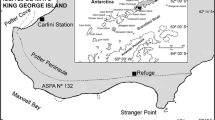Abstract
The diet of ringed seals (Pusa hispida) from coastal and offshore areas of Northeast Greenland was determined by identifying, to the lowest taxonomic limit possible, all hard-part contents from the gastrointestinal tract of 51 seals sampled (2002–2004) in spring (April to June, N = 35) and autumn (September to October, N = 16). The autumn diet was characterized by high numbers of Parathemisto libellula, and the spring diet was comprised primarily of polar cod (Boreogadus saida), with few invertebrates consumed. The coastal seal diet samples had a diverse fish prey composition (during both the spring and autumn), whereas the open water seals had eaten mostly crustaceans with P. libellula being most abundant. The sample sizes from the various locations and seasons were not large enough to explore age-class effects on diet in addition. Similar to earlier studies, this study suggests that the ringed seal is a generalist that exploits prey based on availability, with a few key species dominating the diet in an area at least on a seasonal basis.

Similar content being viewed by others
References
Belikov SE, Boltunov AN (1998) The ringed seal (Phoca hispida) in the western Russian Arctic. NAMMCO Sci Publ 1:63–82
Bowen WD (2000) Reconstruction of pinniped diets: accounting for complete digestion of otoliths and cephalopod beaks. Can J Fish Aquat Sci 57:898–905
Bradstreet MSW, Cross WE (1982) Trophic relations at high Arctic ice edges. Arctic 35:1–12
Browne P, Laake JL, DeLong RL (2002) Improving pinniped diet analysis through identification of multiple skeletal structures in fecal samples. Fish Bull US 100:423–433
Christiansen JS (2003) TUNU I expedition—the fish Fauna of the NE Greenland fjord systems. Technical Report. University of Tromsø, Norway
Christiansen JS, Gamst Moen A-G, Hansen TH, Nilssen KT (2005) Digestion of capelin, Mallotus villosus (Müller), herring, Clupea harengus L., and polar cod, Boreogadus saida (Lepechin), otoliths in a simulated seal stomach. ICES J Mar Sci 62:86–92
Derocher AE, Wiig Ø, Andersen M (2002) Diet composition of polar bears in Svalbard and the western Barents Sea. Polar Biol 25:448–452
Falk-Petersen S, Haug T, Hop H, Nilssen KT, Wold A (2009) Transfer of lipids from plankton to blubber of harp seals off East Greenland. Deep-Sea Res II 56:2080–2086
Gjertz I, Lydersen C (1986) The ringed seal (Phoca hispida) spring diet in northwestern Spitsbergen, Svalbard. Polar Res 4:53–56
Härkönen T (1986) Guide to the otoliths of the bony fishes of the Northeast Atlantic. Danbiu Aps, Hellerup, Denmark
Haug T, Nilssen KT, Lindblom L, Lindstrøm U (2007) Diets of hooded seals (Cystophora cristata) in coastal waters and drift ice waters along the east coast of Greenland. Mar Biol Res 3:123–133
Holst M, Stirling I, Hobson KA (2001) Diet of ringed seals (Phoca hispida) on the east and west sides of the North Water Polynya, northern Baffin Bay. Mar Mamm Sci 17:888–908
Hyslop EJ (1980) Stomach contents analysis—a review of methods and their application. J Fish Biol 17:411–429
Iverson SJ, Field C, Bowen WD, Blanchard W (2004) Quantitative fatty acid signature analysis; a new method of estimating predator diets. Ecol Monogr 74:211–235
Labansen AL, Lydersen C, Haug T, Kovacs KM (2007) Spring diet of ringed seals (Phoca hispida) from northwestern Spitsbergen, Norway. ICES J Mar Sci 64:1246–1256
Lowry LF, Frost KJ, Burns JJ (1980) Variability in the diet of ringed seals, Phoca hispida, in Alaska. Can J Fish Aquat Sci 37:2254–2261
Lydersen C, Gjertz I (1986) Studies of the ringed seal (Phoca hispida) in its breeding habitat in Kongsfjorden, Svalbard. Polar Res 4:57–63
Lydersen C, Gjertz I (1987) Population parameters of ringed seals (Phoca hispida Schreber, 1775) in the Svalbard area. Can J Zool 65:1021–1027
Marcus J, Bowen WD, Eddington JD (1998) Effects of meal size on otolith recovery from fecal samples of gray and harbor seal pups. Mar Mamm Sci 14:789–802
McLaren IA (1958) The biology of the ringed seal (Phoca hispida Schreber) in the eastern Canadian Arctic. Bull Fish Res Bd Can No 118
Pierce GJ, Boyle PR (1991) A review of methods for diet analysis in piscivorous marine mammals. Ocean Mar Biol Ann Rev 29:409–486
Reeves RR (1998) Distribution, abundance and biology of ringed seals (Phoca hispida): an overview. NAMMCO Sci Publ 1:9–45
Siegstad H, Neve PB, Heide-Jørgensen MP, Härkönen T (1998) Diet of ringed seal (Phoca hispida) in Greenland. NAMMCO Sci Publ 1:229–241
Smith TG (1976) Predation of ringed seal pups (Phoca hispida) by arctic fox (Alopex lagopus). Can J Zool 54:1610–1616
Smith TG (1980) Polar bear predation of ringed and bearded seals in the land-fast sea ice habitat. Can J Zool 58:2201–2209
Smith TG (1987) The ringed seal, Phoca hispida, of the Canadian Western Arctic. Can Bull Fish Aquat Sci No 216
Tucker S, Bowen WD, Iverson SJ, Blanchard W, Stenson GB (2009a) Sources of variation in diets of harp and hooded seals estimated from quantitative fatty acid signature analysis (QFASA). Mar Ecol Prog Ser 384:287–302
Tucker S, Bowen WD, Iverson SJ, Stenson GB (2009b) Intrinsic and extrinsic sources of variation in the diets of harp and hooded seals revealed by fatty acid profiles. Can J Zool 87:139–151
Wathne JA, Haug T, Lydersen C (2000) Prey preference and niche overlap of ringed seals Phoca hispida and harp seals P. groenlandica in the Barents Sea. Mar Ecol Prog Ser 194:233–239
Acknowledgments
We thank the hunters in Ittoqqortoormiit and Jonas Brønlund who collected samples for this study and the Norwegian Research Council for an Arctic Stipend that supported AL during the collection of the IT samples. We also thank Rasmus Gregersen who collected the YS samples, Pernille Bondo Harders who helped analyse the YS samples and Jørgen Tranum-Jensen and the crew on R/V Jan Mayen for field assistance. Dr. Jan Marcin Weslawski identified some of the crustacean material. Thanks are also extended to the three reviewers who helped improve this manuscript.
Conflict of interest
The authors declare that they have no conflict of interest.
Author information
Authors and Affiliations
Corresponding author
Rights and permissions
About this article
Cite this article
Labansen, A.L., Lydersen, C., Levermann, N. et al. Diet of ringed seals (Pusa hispida) from Northeast Greenland. Polar Biol 34, 227–234 (2011). https://doi.org/10.1007/s00300-010-0874-0
Received:
Revised:
Accepted:
Published:
Issue Date:
DOI: https://doi.org/10.1007/s00300-010-0874-0




